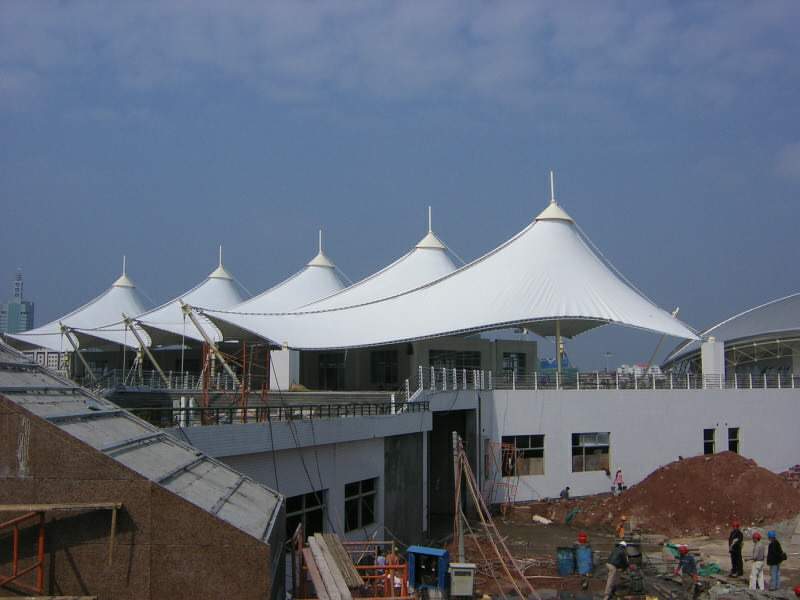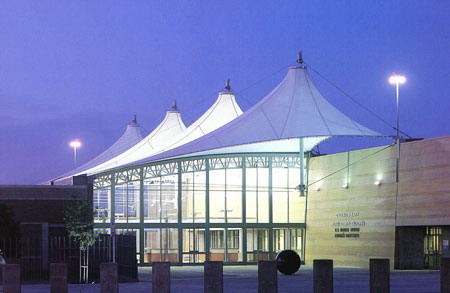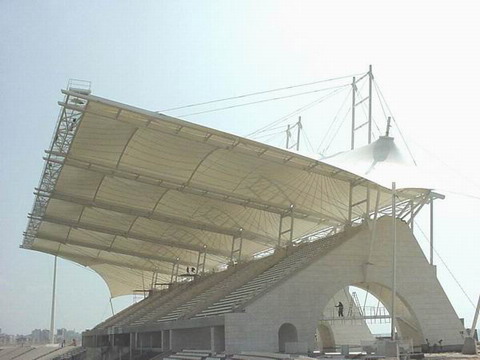Contact HOFO
Mobile:+86 15012841936
WhatsApp:+8615012841936
WeChat:15012841936
Skype:+8615012841936
E-mail:hofosales@hotmail.com
Address: Room 412, Siyufu, Number 10, Nanxin Road, Longgang District, Shenzhen, China
An Introduction to Tensile Fabric Membrane Structures
Tensile fabric structures only carry tension and are commonly used as roofs or canopies for military hangers, athletic facilities, gaming and entertainment structures, etc. While tensile structures can include cable structures, we will only focus on membrane structures in this post.
What are Tensile Fabric Structures?
The three most commonly used membrane materials are PVC, PTFE, and ETFE.
- PVC coated polyester fabric has low cost and life expectancy, so it is more for temporary structures.
- PTFE coated fibreglass has high life expectancy and provides incombustible effect, so it is more for long lasting structures. Although PTFE is expensive, it provides good resistance to UV radiation, wear, weather conditions, and chemical attacks and can have long spans. PTFE does not creep over time.
- ETFE have high tear strength, so they creep when loaded and yield when elongated.
Some advantages of tensile fabric structures include
- Spans with large distances (from 3m to 200m) so less structural steel are needed for roofs
- High strength to weight ratio
- Can produce many shapes, such as arches, saddles, masts, or a combination of shapes
- Fast installation
- Not a lot of construction debris produced after demolition
- Seismic resistance due to its inherent light-weight property
- Free flowing designs for aesthetic look
- Provides space so only few support columns are needed
- Light-weight and flexible structure
- Provide translucency and great light transmission causing reduction in energy costs
- Fire resistance
- Proven durability against stain, UV radiation, corrosion, and weather conditions
The Science behind Tensile Fabric Structure
When the membrane is unloaded, membrane stresses are in equilibrium. When loaded, the membrane stresses are not at equilibrium, therefore the membrane deforms until the stresses are in equilibrium. Therefore, tensile fabric structures need pretensioning to decrease the deflection of the loaded membrane and to increase stiffness of the membrane under imposed loads. Pretensioning also ensures the structure is always in tension. The typical prestress load is around 150-350 kg/meter.
Load Cases and Load Paths
- Wind is the critical load case for tensile fabric structures. A good membrane must have good tensile strength and inherent curvature to resist wind loads.
- Self-weight of membrane should be negligible due to its lightness.
- Seismic loads should also be negligible due to the membrane’s lightness.
- Rain ponding loads should be avoided in the design, since this can lead to deformation failure.
- Tensile fabric membranes should not be designed with concentrated loads. The material of the membrane cannot support high forces perpendicular to membrane. Tensile fabric membranes should only be designed with axial forces in mind.
Gravity loads transfer from the tensile membrane structure to the compression elements, which then transfer the loads to the foundation.
Compression elements resist and transfer lateral loads to the foundation.
The Analysis Process of Tensile Fabric Structures
- The membrane will be modelled as discrete masses with different warp, curvature, direction, and mechanical properties.
- Each finite element or point in the membrane will be represented by nodes.
- Links will be modelled between the nodes as springs.
- Pretension stresses will be inputted to the model and turned into forces in the links.
After modeling the structure and the analysis is running, form finding will begin. During form finding, the nodes will be displaced until the force is equal to zero and static equilibrium is achieved (eg. optimum shape for the membrane is achieved). Mechanical properties, such as geometry, warp orientation, and strength will be also optimized.
Non-linear finite element method analysis will be used to analyze the tensile fabric structure, since the displacement of the fabric structure is not proportional to the loading and the behaviour depends on the prestress value. Also, time dependent factors would need to be analyzed.
From Civilax











